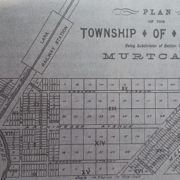Streets ahead at Swindon … sorry, Lara
Major-league changes are unfolding at Lara just now as developers open the rural town’s west to new communities.
Engineers and planners are tramping across paddocks to its west, scrutinising the landscape and its possibilities, picturing in their minds streets and drains, houses and parks.
Magpies wheel about overhead, as they’ve done forever, scrutinising the newcomers but oblivious to the impending growth, and fevered building and activity it will bring.
Duck Ponds as this town was once known is undergoing a transformation with new estate, again. Odd thing, though, the first subdivision plotted for the area never happened.
Had it done so, the town might never have been Duck Ponds let alone Lara. It might have become Swindon.
Few residents of the town’s Archimedes Avenue, or Brunel Close, or Watt Street, are probably aware their home town would have been Swindon had an ambitious 19th-century adventure had his way.
Engineer Edward Snell, in a bid to generate passengers for the Geelong-Melbourne railway that he built in the 1850s, tried to develop Lara as a dormitory suburb of Geelong – the best part of a century before the actual event.
Snell, one of the early Geelong’s most colourful figures, had a subdivision approved with streets named after leading lights from the engineering profession – other names include Stephenson, Smeaton, Nasmyth and Rennie.
The proposed township was named Swindon, after the English town where the great Western Railway Company that Snell worked for prior to coming to Australia built a major rail terminus linking London and Bristol.
“He was about 100 years ahead of his time,” Geelong historical archivist Norman Houghton once told me. “Those things didn’t happen until the 1960s.”
“If you look at a current street directory, some of those names are still there today, south of McClelland Avenue.
“Edward Snell may not have directly involved in selling the subdivision, but the idea certainly was his.”
In many regards, it appears that was Snell all over – an ideas man, forward-thinking and a man typical of the intrepid breed of fortune-seekers who flocked to Australia at the time of the Gold Rush.
Snell actually arrived just before the Gold Rush but did try his luck, to small avail, on the diggings. His fortune was gleaned from the Geelong-Melbourne line and not without considerable fame and controversy.
Snell worked variously as an engineer, architect, draftsmen, surveyor and artist. He was an avid diarist and his writings about early Geelong, Adelaide, the Yorke Peninsula, Tasmania, the Murray and the goldfields are peppered with anecdotes, sketches and caricatures as well as intriguing insights into colonial Australia.
“Snell was a man of immense talent and abilities and seized his chance,” Houghton said.
Snell came under intense pressure after locomotive engineer Henry Walter was killed on the rail line’s opening day when he struck his head on a Cowie’s Creek bridge beam while waving to the nearby crowd.
According to Houghton, Snell also failed to get along with Alexander Thomson, one of Geelong’s leading pioneers, who thought the engineer’s work was sloppy.
Certainly Snell had problems of his own, according to his diaries, with his business partners, but his indomitable nature allowed him to persevere and after returning to England he retired at a youthful 38.
Who knows? Had he become a successful land developer he might have stuck around.
Might have even had a street named after himself.

